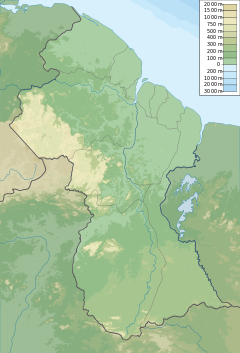| Kurubrang River | |
|---|---|
| Location | |
| Country | Guyana |
| Physical characteristics | |
| Mouth | Potaro River |
• coordinates | 5°24′00″N 59°10′00″W / 5.40000°N 59.16667°W[1] |
The Kuribrong River is a river of Guyana, a tributary of the Potaro River 2 miles north east of Potaro Landing.[2]
The Kuribrong is a part of the Essequibo River basin, and supports endemic fish species.[3]
The geological make up of the river is schistose quartz-porphyrite and sericite schist, and quartz boulders making up any major river obstruction. The river was deemed to be of low interest for gold mining, to contrast with other rivers of the region.[2]
YouTube Encyclopedic
-
1/1Views:380
-
Exploring Guyana
Transcription
Economic use
There is a settlement at "Kuribrong River, Mona Falls" with a population of 28 in the 2012 census.[4]
It was considered for a now-defunct hydroelectric project, at the confluence with the Amaila River.[5][6]
Balata bleeding was once done in the area of the river.[7]
See also
References
- ^ "Kuribrong River, Guyana - Geographical Names, map, geographic coordinates".
- ^ a b Geologist, British Guiana Government (1900). Report on the Geology of the Essequibo, Potaro, Konawaruk and Demerara Rivers. C.K. Jardine, printer to the government of British Guiana. pp. 14–20.
- ^ Lujan, Nathan K.; Armbruster, Jonathan W.; Werneke, David C.; Teixeira, Túlio Franco; Lovejoy, Nathan R. (2020-03-26). "Phylogeny and biogeography of the Brazilian–Guiana Shield endemic Corymbophanes clade of armoured catfishes (Loricariidae)". Zoological Journal of the Linnean Society. 188 (4): 1213–1235. doi:10.1093/zoolinnean/zlz090. ISSN 0024-4082.
- ^ "Publications – Bureau of Statistics – Guyana". Retrieved 2021-02-01.
- ^ "Anatomy of the Amaila Falls Hydro Power Project ‒ Geo-technical dimensions)". Stabroek News. 2013-06-16. Retrieved 2021-02-01.
- ^ "Notice of Hydro-Electric Power Application" (PDF). Official Gazette. 27 July 2002. Retrieved 2021-02-01.
- ^ Guiana, British (1911). The Official Gazette of British Guiana. p. 242.
Bibliography
- Rand McNally, The New International Atlas, 1993.

